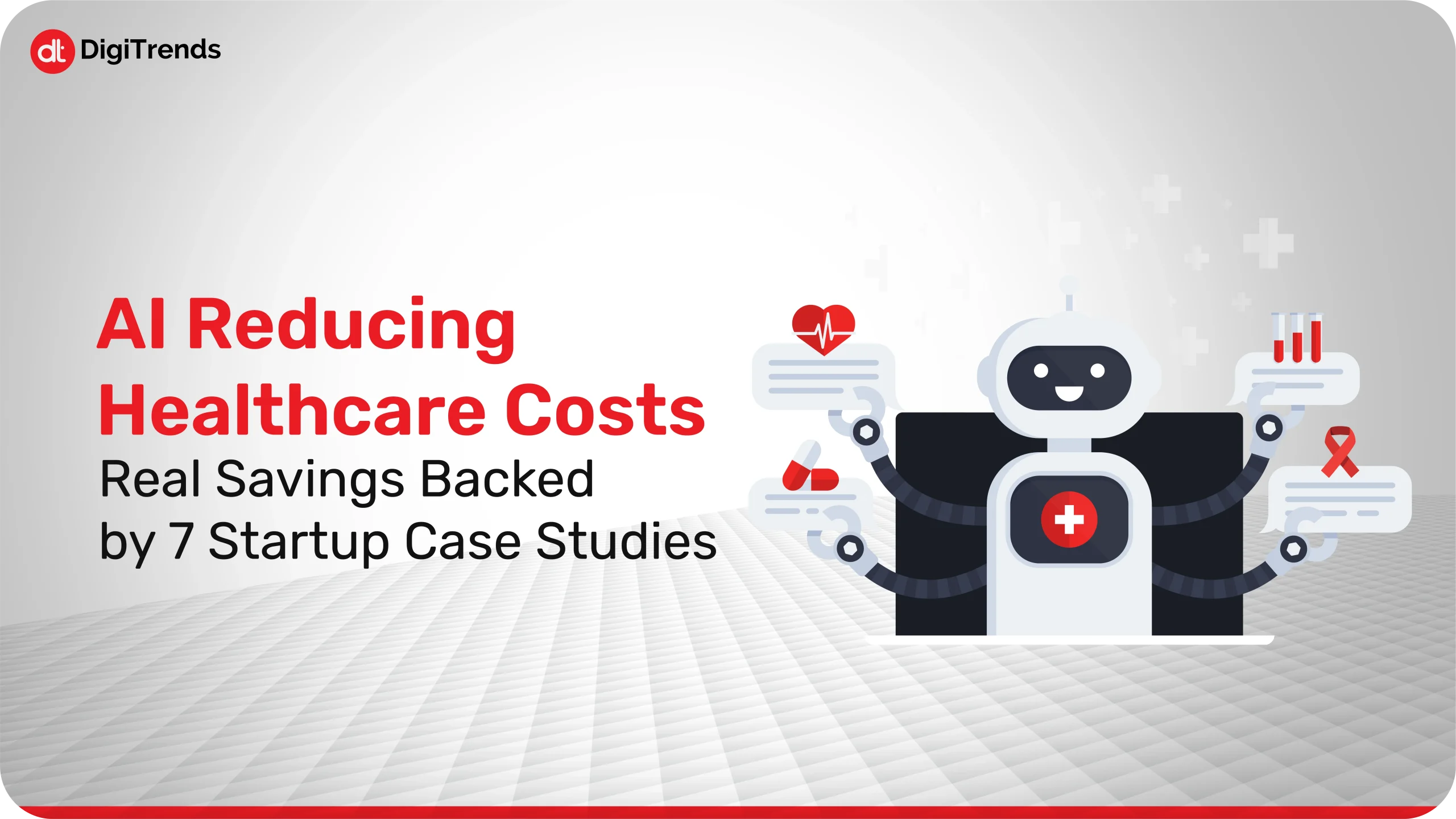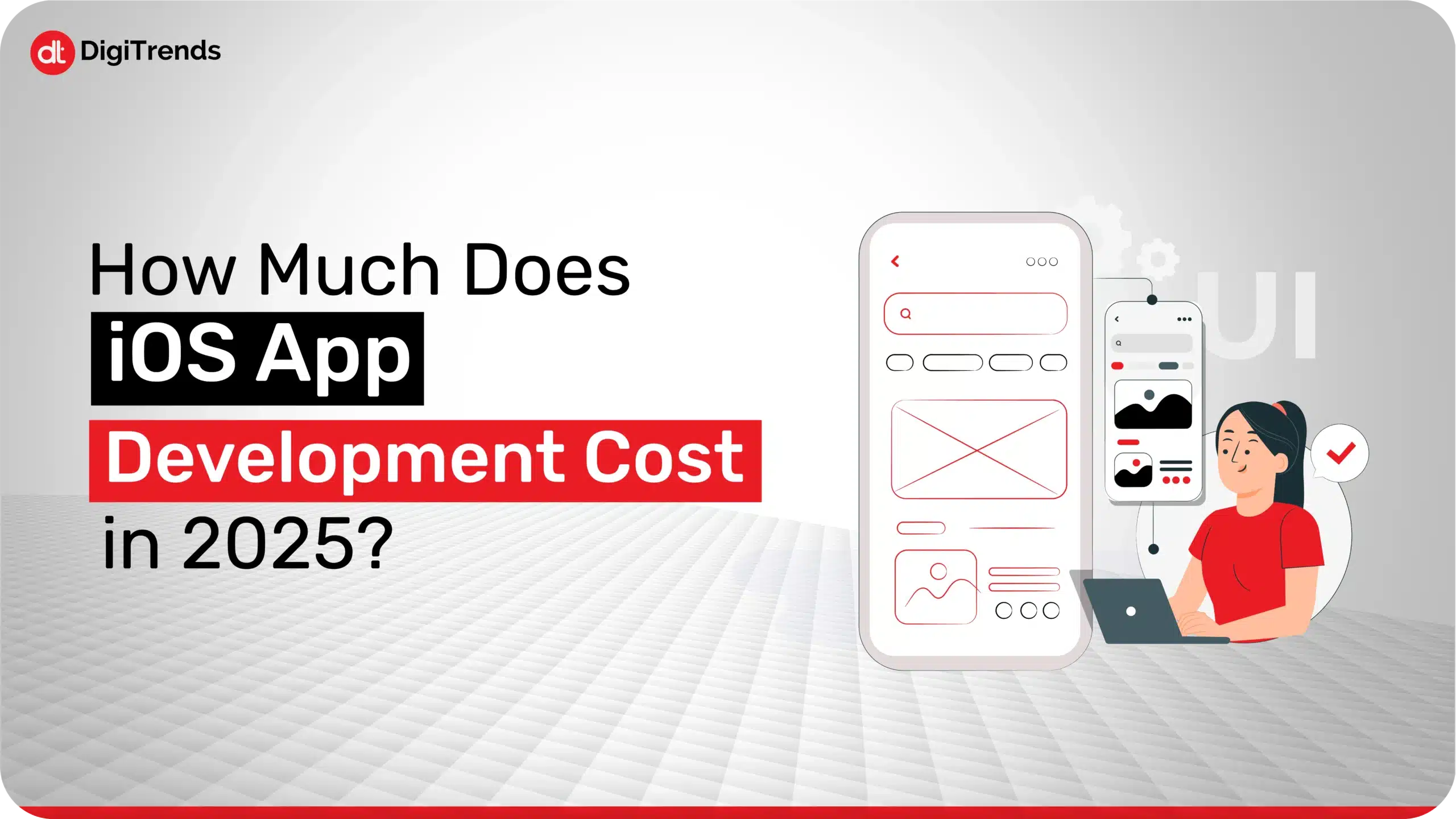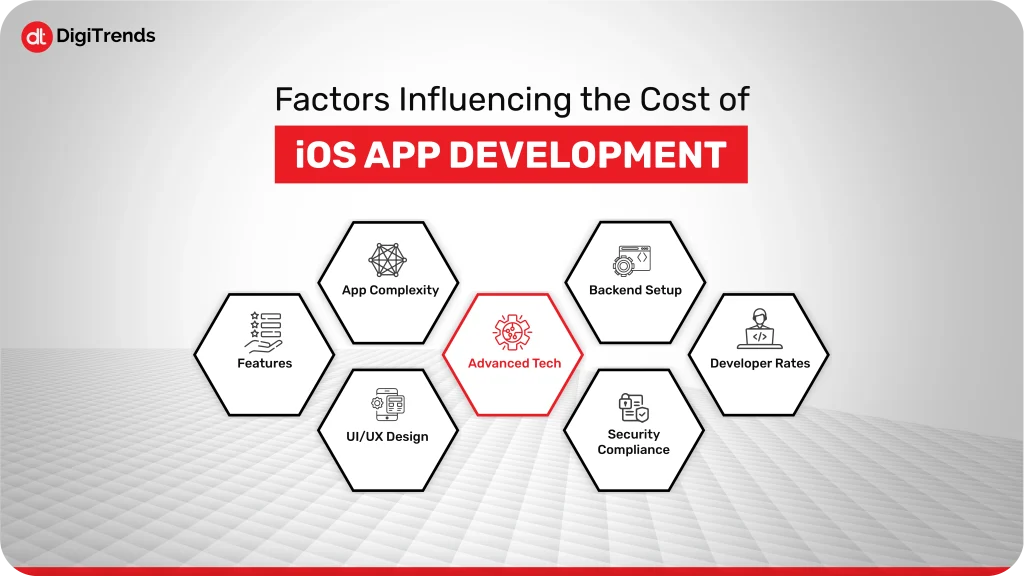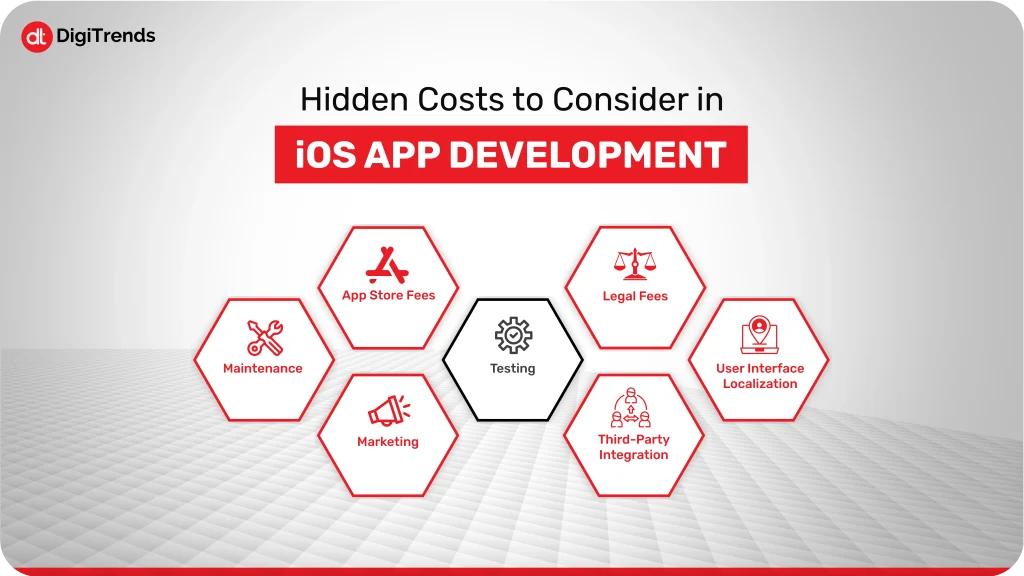
AI Reducing Healthcare Costs: Real Savings Backed by 7 Startup Case Studies
Look at the real numbers from healthcare organizations that show AI reducing healthcare costs in real. The AI lens makes costs look controllable.
Continue Reading
Choosing the right platform for your app development must have been the toughest! Right?
But the decision-making doesn’t stop here; you now need to create a budget for your iOS app development.
Don’t worry!
Now that you have decided to build your app on the iOS platform, let’s help you find out the iOS app development costs and insights on how you can plan your budget.
iOS is now one of the most profitable platforms for app development. According to Backlinko, there are over 2.2 billion active Apple devices worldwide. Whether it is smartphones, tablets, or any other devices, Apple dominates several markets both domestically and internationally. It is also reported that the App Store attracts nearly 650 million users every week.
Let’s break down the iOS app development costs by analyzing the important cost factors such as the complexity of the app, development time, and more.
This blog will help you get a clear understanding of the iOS app development costs. Whether it’s a startup or an existing business looking to improve their app, this blog caters to all.
The mobile application industry has grown a lot, and Apple’s system is still the best when it comes to new ideas and investment.
The App Store has more than 1 million apps, and thousands of new ones keep on being added regularly, which makes iOS development more competitive, and creating a user-friendly app doesn’t only require good functionality.
It needs professional UI/UX design, a well-performing site, and successful marketing. One should always consider discovery, user retention, and compliance matters when thinking about iPhone app development costs due to Apple’s new privacy rules. It is important to learn about these market trends to create a reasonable budget for your iOS app and to avoid any surprises related to costs in the future.
In 2025, developing an iOS app is still a good choice to connect with a valuable group of users and use Apple’s powerful resources. Since iOS users spend and use apps more, mobile strategies from several companies are often centered on iOS, which is completely logical.
But how much does iOS app development cost in 2025?
Let’s explore the costs of developing an iOS app in 2025. This breakdown of the iPhone app development costs will provide an overview of the expenses needed to develop various types of iOS apps, ranging from basic prototypes to comprehensive, enterprise-grade solutions.
| App Type | Estimated Cost (USD) | Development Time | Description |
| Basic App | $15,000 – $50,000 | 2 – 4 months | MVPs, simple tools, internal business utilities |
| Mid-Level App | $55,000 – $100,000 | 4 – 8 months | E-commerce, booking apps, and content platforms |
| Complex App | $100,000 – $300,000+ | 8 – 12+ months | Social media, real-time apps, AI/AR-powered apps |
iOS application development costs can vary widely from $170,000 – $450,000 + based on the type of app. Having a clear estimate helps align your goals, set realistic expectations, and plan your budget effectively.
This cost range is basic; to find out the main factors that determine iPhone app development price, you have to examine what affects costs.
Let’s explore these factors that influence iOS application development costs:

If you’re planning to create an iOS app in 2025, you should think about all aspects of iOS app development costs.
The answer to how much iOS application development costs isn’t straightforward. iPhone app development costs can vary widely depending on the type of application you want to create, the complexity of the application, the technology required to make the application, the person or company making the application and their location.
Developing an app requires more than just a great idea; it needs a strong focus on strategy, design, and development.
No matter if you are developing a basic MVP (Minimum Viable Product) or a comprehensive, AI-driven platform, you have to know how each factor will contribute to influencing the development costs because it can help you avoid unexpected costs later on.
Let’s have a look at the factors affecting iOS app development costs:
The complexity of the app is the main factor that decides the iOS app development cost. For example, if you want to create a simple app with very few tools, then the cost will be a lot less than creating an app with complex tools such as live-chat features or a social media or fintech app that requires a high level of functionality.
The other main factor that will decide the iOS app development cost is functionality. As mentioned before, if the app requires more high-level functionalities, then the cost will be higher. Basic features such as push notifications, in-app transactions, user accounts, and payment processing are quite common but still require configuration and testing. On the other hand, adding more elements like AI-based suggestions, augmented reality (AR) will significantly increase the expenses due to the need for specialized expertise and extra development time.
The users nowadays don’t only look for a visually appealing app, they also want the app to be engaging as well. Especially Apple users want apps to be smooth and an interface that can reflect the brand’s identity. Sleek UI/UX design includes creating wireframes, mapping user journeys, building prototypes, and incorporating animations. The more unique and interactive the design is, the greater the costs for design and development will be. While designing a more intuitive app may increase your expenses, it also greatly enhances user retention and engagement.
The backend of your app serves as its unseen framework. It handles data storage, user administration, authentication, server processes, APIs, and other critical functions. While a basic backend for simple data storage might be cost-effective, a scalable, secure, cloud-based backend, particularly if it features third-party integrations, real-time synchronization, or support for multiple languages, can rapidly become a significant portion of your development expenses.
In 2025, advanced technologies such as AI, machine learning, augmented reality (AR), virtual reality (VR), and blockchain are increasingly integrated into various applications, yet they also come with higher costs. For instance, adding features like natural language processing or image recognition typically demands more development time, the use of sophisticated frameworks, APIs, and occasionally specialized infrastructure such as Core ML or custom AI models. While these technologies provide significant value, they tend to increase the cost of app development.
Given Apple’s increased focus on privacy and security regulations, particularly with the upcoming iOS 18 updates, ensuring that your app meets compliance standards is more critical than ever. Capabilities such as end-to-end encryption, biometric authentication, and adherence to GDPR and CCPA, along with secure data management, have become necessities rather than options. Properly implementing these features demands time, specialized knowledge, and often the use of third-party solutions, all of which affect the overall expenses involved.
The location of your app developers and who they are can greatly influence the overall cost. Hourly rates for developers can differ widely based on their geographical region. For instance, developers from the US, UK, or Western Europe typically charge rates ranging from $100 to $200 per hour, whereas those from Eastern Europe or South Asia generally ask for between $25 and $70 per hour. Although outsourcing may lower initial expenses, it’s crucial to strike a balance between budget considerations and the aspects of quality, experience, and effective communication.
When you consider all these factors, it’s evident that the cost of developing an iOS app in 2025 can range significantly. By understanding how each element influences your overall expenses, you can plan more realistically and avoid unexpected costs throughout the process.
Not all mobile applications are the same, and neither are their development costs. In 2025, iOS app development costs vary widely depending on the industry and the particular type of app you are creating. For instance, a simple quiz application will not be nearly as expensive as a high-quality mobile game featuring real-time multiplayer options.
Various app categories require different technologies, design criteria, and backend systems, which can significantly affect the total cost.
Below is a summary of average development costs for iOS apps by category to assist you in determining where your project may be positioned.
| iOS App Category | Development Time | Estimated Cost (USD) |
| Medical app | 2 – 6 months | $40,000 – $90,000 |
| Shopping app | 4 – 8 months | $6,000 – $45,000 |
| Gaming app | 5 – 20 months | $30,000 – $250,000 |
| Fintech app | 4 – 12 months | $100,000 – $250,000 |
| Social networking app | 6 – 8 months | $10,000 – $70,000 |
| Business app | 3 -12 months | $6,000 – $150,000 |
| Entertainment app | 4 – 15 months | $15,000 – $100,000 |
| Health and fitness app | 2 – 14 months | $150,000 – $250,000 |
| Education app | 3 – 12 months | $15,000 – $80,000 |

When planning a budget for iOS app development, many companies prioritize obvious costs such as design and development. Nonetheless, numerous hidden iOS app development costs can arise during the process. Overlooking these factors may result in underestimating your overall investment and cause delays in your launch or growth.
Here are the key hidden costs you should consider:
Testing plays a vital role in confirming that your application functions properly on all iOS devices, varying screen sizes, and multiple iOS versions. Quality Assurance can comprise 15–25% of your overall budget, particularly for intricate applications with real-time functionalities or API integrations, whether it’s manual or automated testing.
Apple requires a yearly payment of $99 for its Developer Program, which is necessary to distribute apps on the App Store.
After launching your app, the efforts continue. Continuous maintenance involves addressing bugs, enhancing performance, applying security updates, and ensuring compatibility with new iOS versions. This usually requires an annual budget of 15–20% of the initial development costs.
Even top-notch apps require marketing efforts. Marketing expenses, which may include ASO (App Store Optimization), social media advertisements, influencer collaborations, and public relations, can vary from $5,000 to over $50,000, depending on your objectives and scope.
Applications that manage user information, particularly in sectors such as healthcare or finance, are required to adhere to regulations such as GDPR, HIPAA, or CCPA. Compliance may necessitate legal advice, the creation of policies, and the establishment of data encryption, all of which contribute to your expenses.
Are you looking to incorporate a payment gateway, analytics tool, or CRM solution in your app? A lot of these services come with subscription or usage-based charges (such as Stripe, Firebase, or Twilio), and some might also need additional development time for integration.
When aiming for international markets, it’s essential to translate your content, modify the user interface for various languages, and consider cultural differences. Localization goes beyond mere translation and can lead to considerable expenses for each additional region you cater to.
Although these hidden costs may appear minor on their own, they can quickly add up and catch you off guard if not considered early. By budgeting for them in advance, you’ll ensure a smoother development process and a more sustainable app lifecycle.
Developing an iOS app can be a major investment, but you can effectively manage costs without sacrificing quality. Here are some useful tips:
Companies like DigiTrends are known for building scalable and user-centric digital products. They offer the expertise and insight needed to turn ideas into high-performing apps. Partnering with an experienced team ensures your investment will lead to real business growth.
By applying these strategies, you can keep your iPhone app development price less while still delivering a user-friendly app.
As you prepare for the future, it’s essential to foresee the upcoming technologies that will influence the iOS app development costs.
While current expenses are determined by features, design, and backend requirements, future costs will be influenced by:
Apple is making significant investments in on-device AI, focusing on cutting-edge natural language processing with SwiftGPT and enhanced Core ML pipelines. Anticipate an increase in development time (and specialist fees) as teams create and refine tailored language and vision models that operate natively on iPhone and iPad.
As Vision Pro is becoming more widely available, the need for spatially aware applications that integrate AR and VR will rise. Creating 3D assets, spatial audio, and interactive environments necessitates a combination of design and engineering skills, leading to project budgets that are 20–30% more than those for 2D app development.
Apple’s privacy initiatives are consistently advancing, bringing in additional requirements for on-device processing, secure enclaves, and data minimization. Incorporating these protections (such as Private CloudKit and improved encryption) will increase the complexity and expense of your backend and client-side development.
As the number of devices integrated into Apple’s ecosystem increases from HomeKit gadgets to HealthKit wearables, applications that require real-time synchronization across hardware will necessitate strong architectures and additional testing phases. Ensuring smooth, low-latency data transfer may increase your development and QA budgets by 10–15%.
In order to stay aligned with swift OS upgrades and various device types, developers might focus on creating highly modular structures and common component libraries. The initial expense of establishing these foundations can be considerable, but they yield considerable savings in maintenance over the long term.
By staying updated on these developing trends, you’ll be more prepared to allocate your budget not only for current needs but also for the future generation of iOS experiences, ensuring that your app stays competitive and financially viable.
The development of iOS applications in 2025 relies on careful budgeting and strategic planning. Understanding the cost categories for simple, mid-level, and advanced applications and considering additional costs such as App Store fees, maintenance, and marketing will enable you to create realistic budgets right from the start.
Keep in mind that effective expense management starts with careful planning: begin with a minimum viable product, focus on essential features, and select your development team thoughtfully. As you’ve observed, upcoming trends such as on-device AI, spatial computing, stricter privacy regulations, and fluid IoT integrations will influence future costs, so include some additional flexibility in your budget now to remain ahead of the trends.
In the end, investing in high-quality solutions today yields benefits in the future. A carefully constructed and well-designed iOS app not only pleases users but also sets your business up for growth and lasting success. This blog will help you combine them with your targets and develop a plan that unites your goals with your finances.Having a skilled development team like DigiTrends and the right set of features and technologies will let you launch an iOS app that measures up to the users’ demands in 2025.
